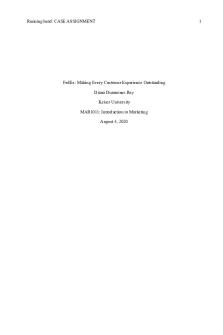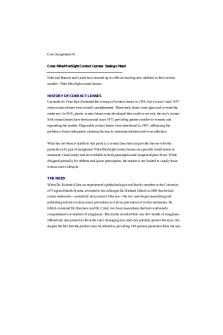BUSI 472 Case Assignment 1 PDF

| Title | BUSI 472 Case Assignment 1 |
|---|---|
| Author | Gloriann Schaefer |
| Course | Organizational Ethics |
| Institution | Liberty University |
| Pages | 8 |
| File Size | 97.7 KB |
| File Type | |
| Total Downloads | 55 |
| Total Views | 167 |
Summary
Online - Kathryn McMahon...
Description
Running head: CASE ASSIGNMENT 1
1
Case Assignment 1: Monsanto Attempts to Balance Stakeholder Interests Liberty University
CASE ASSIGNMENT 1
2 Abstract
This paper will discuss Monsanto’s ability to maintain and balance the interest of their stakeholders. It will discuss how and if Monsanto upholds an ethical culture that responds to various stakeholders. A comparison study will be also provided on the costs and benefits of growing genetically modified (GM) seeds for crops. Lastly, the article will how Monsanto should manage the potential harm their products, such as Roundup, may bring to plants and animals. Keywords: Monsanto, GMO, GM, Roundup, ethics, stakeholders
CASE ASSIGNMENT 1
3
Case Assignment 1: Monsanto Attempts to Balance Stakeholder Interests The Monsanto Company is the largest seed company in the world, with sales over $15.9 billion (Ferrell, Fraedrich, & Ferrell, 2017). Monsanto specializes in producing genetically modified seeds utilizing the science of biotechnology. Founded in 1901, Monsanto came into the game of genetically engineered crops in the early 1970s, becoming one of the top producers in the world. The company aims to modify crop using gene technology to insert of modify genes in different crops to increase crop yields and ward off insects. Monsanto maintains an ethical culture that effectively responds to various stakeholders. The only thing that founder of Monsanto, John Queeny, could be accused of is being too opened with his employees and stakeholders in the amount of information he disclosed (Mahoney, 1991). There are costs and benefits when it comes to growing genetically modified (GM) seeds for crops. Monsanto should manage the potential harm to plant and animal life from using products such as Roundup keeping that in mind with the production of their new products and providing warnings and documentations when they are in use to protect those from harm. As the concern of the well-being of the people and the plant grows within the views of Monsanto stakeholders, the company works to keep this in mind as they continue to develop new products and maintain ethical standards. God calls us to live a life above reproach and to be set apart from those around us. Christians have a moral responsibility to live a holy life as it says in 1 Peter 1:14-16 that we are called to be holy just as God is holy. Therefore believers must be the standard for ethical business standards and practice business in a way that honors the Lord and protects God’s creation.
CASE ASSIGNMENT 1
4 Efficacy of Monsanto’s Ethical Culture
Business ethics is no longer a part of corporation culture but now has become a moral responsibility of companies. Monsanto works hard to maintain an ethical culture that fully satisfies the needs and desires that their stakeholders have for their company output and product creation. This comprises addressing the issues of GM safety, environmental issues, and organizational ethical issues including patent and legal issues. The company also tries as a corporation to give back to the community by providing sustainable agriculture and charitable giving. The Environmental Protection Agency (EPA) and New York Medical College claim that the ingredient in Roundup, glyphosate, has low toxicity levels and does not create a health risk to humans (Ferrell, Fraedrich, & Ferrell, 2017). The Agricultural Appropriations Bill of 2013 has faced much controversy. There is a provision that states that GM food cannot be barred from sale even if future health risks are revealed. Critics believe that provision slipped in at the last moment however Congress would not have overlooked even the smallest or last provision of the bill before approving it. The FDA and the American Association for the Advancement of Science have both proclaimed that GM good is safe to consume and the European Commission has examined more than 130 studies and have found that GM food does not appear to be riskier than any other crops grown by conventional methods (Ferrell, Fraedrich, & Ferrell, 2017). Founder of Monsanto, John Queeny, stood on the ground of the idea that there is no right way to do the wrong thing (Mahoney, 1991). This train of thought has been ingrained in the style of thinking that Monsanto enforces within their company. It has never been the company’s goal to persuade and convince their consumers that their product is something it is not. Monsanto strives to keep its reputation despite the backlash it has faced for the safety and risk that its
CASE ASSIGNMENT 1
5
products may entail but have always attempted to provide evidence for their argument against these accusations. Costs and Benefits of Growing GMO Seed While the Monsanto Company may have their critics, supporters stand by their side stating that the company changes the game of world hunger by producing more crops and supplying a hardier food supply. However, critics accuse Monsanto of attempting to take over the world’s food supply and decreasing biodiversity (Ferrell, Fraedrich, & Ferrell, 2017). There has also been an expression of concern for the negative effects that biotechnology has on the health of people and the environment. The costs of the use of GM seeds in the growing of crops are obvious in how the effects new implementation of growing methods can affect both the environment and the population. Some of the biggest risks found in the use of GMOs are the effects on the plants around the new growth, the affect of seeds on the animals within the area, the unknown risks to the human body, and the nonspecific ecosystem disruption (Ando & Khanna, 2000). It is proven that incorporated GM crops has affected biodiversity. This can result in an unbalance in the ecosystem, something that Monsanto should be watchful of when incorporating their herbicide resistant crops (Tsatsakis, 2017). The use of herbicides and pesticides by Monsanto have resulted in the contamination of organic farming fields and native plants. Due to uncontrollable environmental factors like the winds and insects, the company cannot always prevent the contamination. Despite the costs that may appear in the use of GM seeds, the benefits of the incorporation of GMOs in farming comes with its benefits. Just as promised, the use of GMOs has yielded more produce in both quality and quantity (Robaey, 2016). As the advancement in the world of genetically modified crops continues, new ways are found for GM seeds not only to
CASE ASSIGNMENT 1
6
yield greater quantities of produce but also quality. The health gains of GM crops outweigh the costs of production and commercialization as they are helping those in need of more nutrition in their limited supplies of food (Steur, Wesana, Blancquaert, Der Straeten, & Gellynck, 2017). Management of Harm to Plants and Animals Monsanto has a moral responsibility to manage the potential harm to plant and animal life from the use of their products such as Roundup (Robaey, 2016). As the company continues to grow and society moves towards an organic way of producing and consuming food, Monsanto must fight to keep their products in the top tier of farming in order to stay in the field of crop production. It is highly recommended that the effects of these chemicals be reevaluated by improving the protocols with respect to exposure time and cumulative toxicity of different GM food/feed mixtures (Tsatsakis, 2017) Monsanto has a responsibility for developing epistemic virtues and defining a range of actions to deal with these kinds of problems, uncontrollable factors are not a viable excuse to not address the issues (Robaey, 2016). However, Monsanto is working diligently on their creations of herbicide resistant seeds and moving towards creating GM seeds that will make the use of herbicides and pesticides obsolete because the ingredients will already be in the plants themselves. Studies have shown that small concentrations of Roundup can be harmful to birds, insects, and amphibians. While other studies have suggested that the herbicide might have a harmful effect on human cells (Ferrell, Fraedrich, & Ferrell, 2017). However, when used at the recommended doses, Roundup is not harmful to the human body, says EPA.
CASE ASSIGNMENT 1
7 Conclusion
Monsanto maintains an ethical culture that effectively responds to various stakeholders. The benefits of growing GM seeds for crops outweigh the potential negative consequences of using them due to the increase in quality and quantity of the produce supplied. Monsanto must work to manage the potential harm that products like Roundup can cause animals and plants by working diligently to produce new products that will make their pesticides and herbicides obsolete or making improvements to their products to prevent contamination and detriments to the health and well-being of the environment, animals, and people.
CASE ASSIGNMENT 1
8 References
Ando, A. W., & Khanna, M. (2000). Environmental Costs and Benefits of Genetically Modified Crops: Implications for Regulatory Strategies. American Behavioral Scientist, 44(3), 435–463. Ferrell, O. C., Fraedrich, J., & Ferrell, L. (2017). Business Ethics: Ethical Decision Making and Cases (11th ed.). Boston, MA: Cengage Learning. Mahoney, R. J. (1991). Ethics: Doing the Right Thing at Monsanto. Management Accounting, 72(12), 24. Robaey, Z. H. (2016). Gone with The Wind: Conceiving of Moral Responsibility in The Case of GMO Contamination. Science and Engineering Ethics, 2016, 22(3), 889-906. Steur, H., Wesana, J., Blancquaert, D., Der Straeten, D., & Gellynck, X. (2017). The Socioeconomics Of Genetically Modified Biofortified Crops: A Systematic Review And Meta‐ Analysis. Annals of the New York Academy of Sciences, 1390(1), 14-33. Tsatsakis, A. M., Nawaz, M. A., Tutelyan, V. A., Golokhvast, K. S., Kalantzi, O., Chung, D.H, Kang, S.J., Coleman, M.D., Tyshko N., Chung, G., Yang, S. H. (2017). Impact on Environment, Ecosystem, Diversity and Health from Culturing and Using GMOs As Feed and Food. Food and Chemical Toxicology, 107(Pt A), 108-121....
Similar Free PDFs

BUSI 472 Case Assignment 1
- 8 Pages

BUSI 3403 - Case Analysis 2
- 9 Pages

Week 1 Case Assignment
- 4 Pages

Assignment 1 case study
- 10 Pages

Assignment 1 CASE Study
- 9 Pages

Assignment 1 Zipcar Case
- 2 Pages

Case Study Assignment 1
- 21 Pages

Assignment Case 1
- 4 Pages

Assignment Case Study-1
- 6 Pages

Resolucion 472 DE 2017
- 18 Pages

Case 1 - Airbnb and Assignment
- 4 Pages

Avion case study 1 - Assignment
- 4 Pages

CASE Study 1- Facebook - Assignment
- 19 Pages
Popular Institutions
- Tinajero National High School - Annex
- Politeknik Caltex Riau
- Yokohama City University
- SGT University
- University of Al-Qadisiyah
- Divine Word College of Vigan
- Techniek College Rotterdam
- Universidade de Santiago
- Universiti Teknologi MARA Cawangan Johor Kampus Pasir Gudang
- Poltekkes Kemenkes Yogyakarta
- Baguio City National High School
- Colegio san marcos
- preparatoria uno
- Centro de Bachillerato Tecnológico Industrial y de Servicios No. 107
- Dalian Maritime University
- Quang Trung Secondary School
- Colegio Tecnológico en Informática
- Corporación Regional de Educación Superior
- Grupo CEDVA
- Dar Al Uloom University
- Centro de Estudios Preuniversitarios de la Universidad Nacional de Ingeniería
- 上智大学
- Aakash International School, Nuna Majara
- San Felipe Neri Catholic School
- Kang Chiao International School - New Taipei City
- Misamis Occidental National High School
- Institución Educativa Escuela Normal Juan Ladrilleros
- Kolehiyo ng Pantukan
- Batanes State College
- Instituto Continental
- Sekolah Menengah Kejuruan Kesehatan Kaltara (Tarakan)
- Colegio de La Inmaculada Concepcion - Cebu


